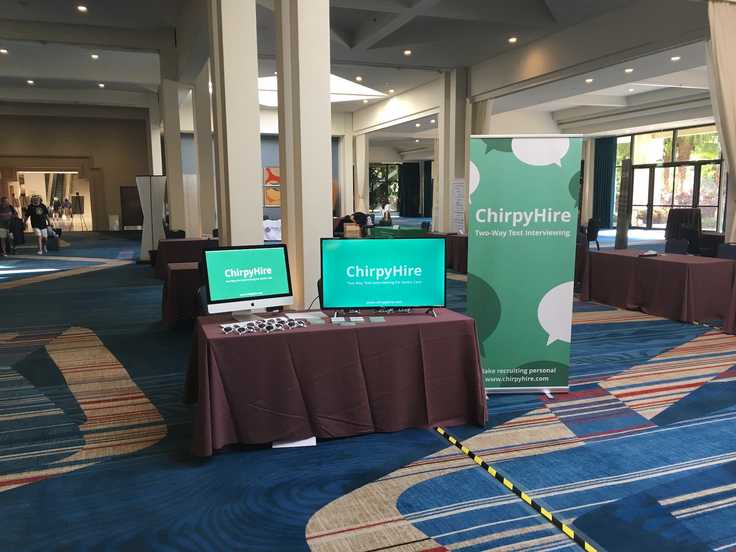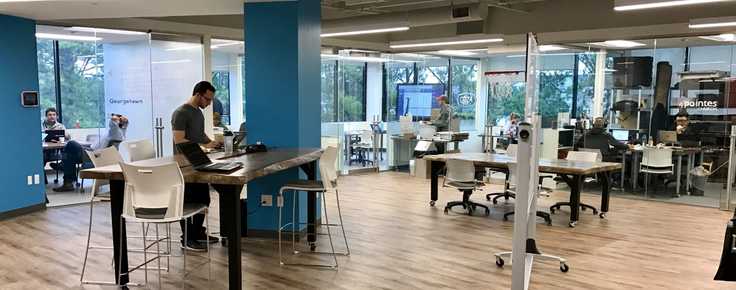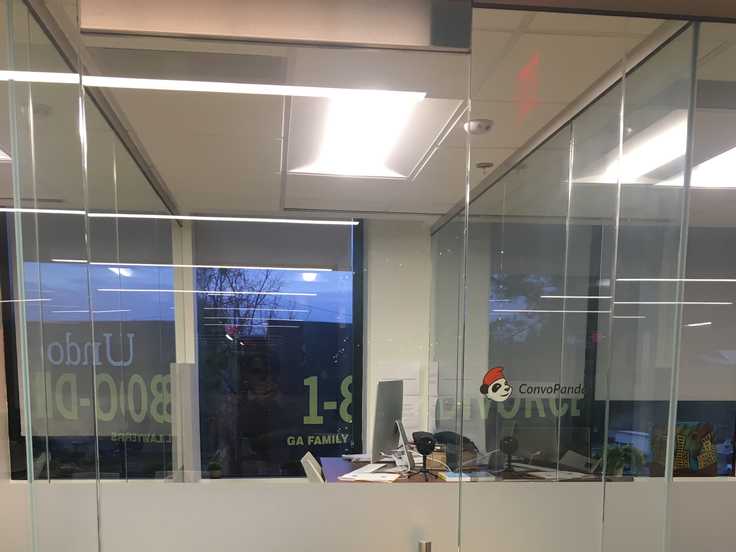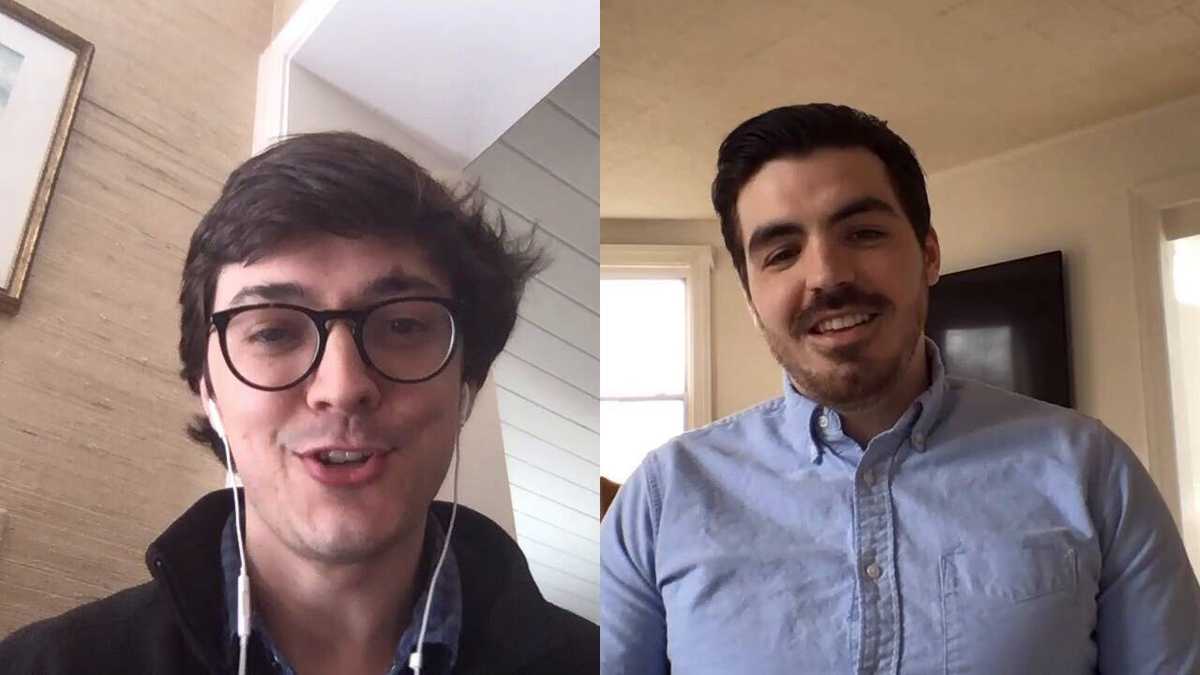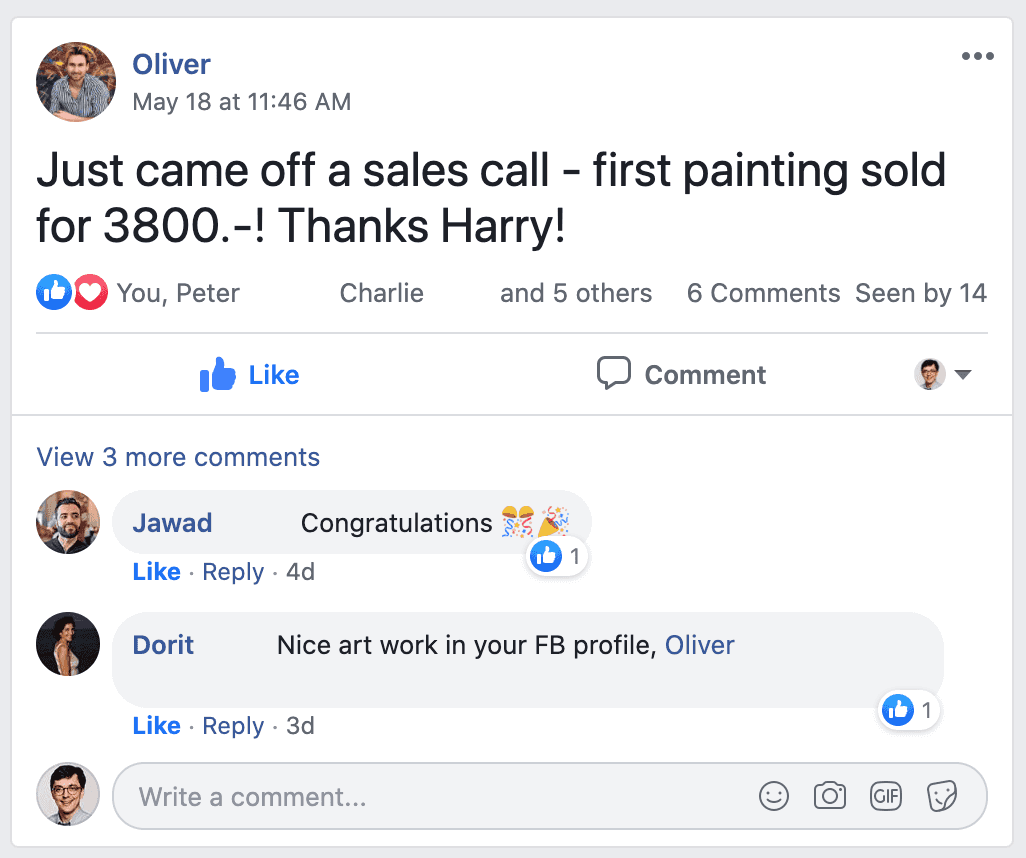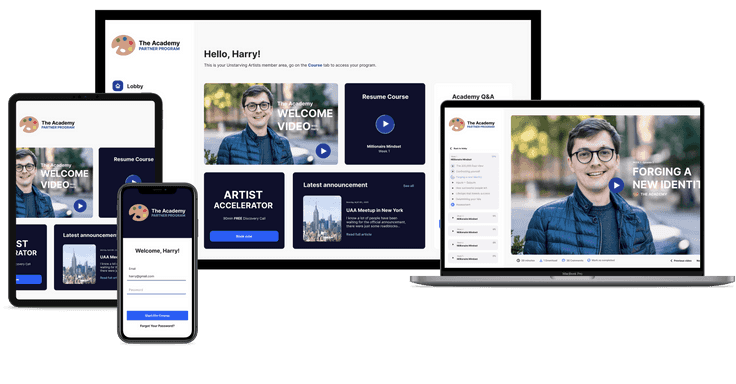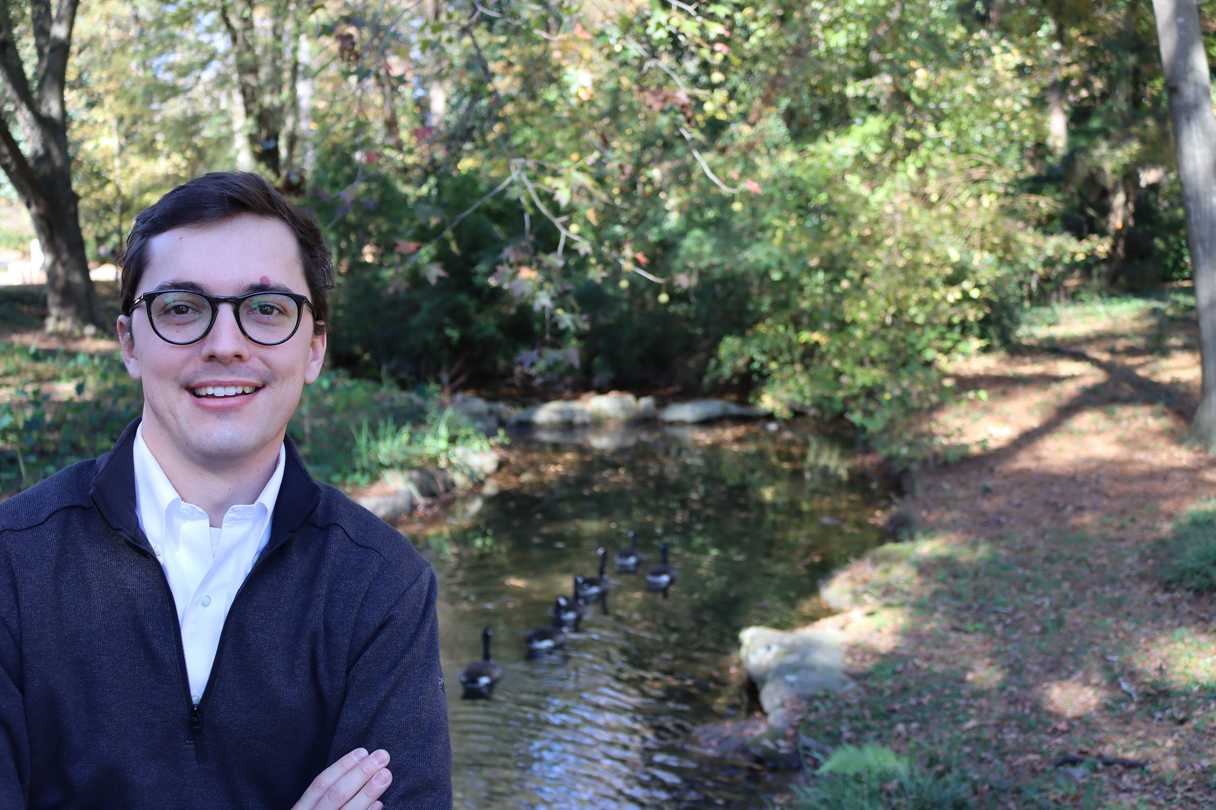
MeetBrandon Miles
Multi 6-Figure Art Market Consultant & Founder of Unstarving Artists

Multi 6-Figure Art Market Consultant & Founder of Unstarving Artists
Brandon Miles is a multi 6-figure art market consultant working closely with over 200 semi-professional and professional artists spanning more than 12 countries.
His flagship training programs have produced 3 millionaires, dozens of six-figure earners, and allowed many everyday people to become full-time artists.
Hi, I’m Brandon Miles, and I’d like to share a bit of my story with you.
I grew up in Atlanta, GA in an everyday, white-collar, middle-class family, and I didn't know anything else. I was taught to work hard in school, live frugally, and pursue the well-worn path of going to college and then getting a white-collar corporate job.
In fact, when I had graduated from college at 21 years old and landed a job at a digital marketing agency for the Fortune 500, I became a family "success" story.
And that's what my view of success had been as long as I could remember. You "made it" if you were in a salaried role working in an air-conditioned office.
But all that would soon change...
There was one sense in which my college experience was quite unique. You see, I was in a men's a cappella group. We sang classic songs and wore bowties—the whole nine yards.
One year, our group's president was able to secure us an invitation to spend spring break on a cruise ship in exchange for us performing on board. Envisioning us spending a few days off the coast of Florida on a crowded ship filled with young people, I said, "Sure, why not", and we were on our way.
You can imagine my surprise when we ended up on an all-inclusive luxury cruise ship sailing from Australia to Singapore over 10 days. This was no 3-day Florida cruise.
In fact, in exchange for our performances, they put us up in cabins that ran $25,000 per person—if we had been paying guests.
I don't know if other people who didn't grow up rich have this same type of experience, but being exposed to the type of wealth that can spend that kind of money on a spring break vacation completely opened my eyes to a world I had never even imagined.
Up until this moment, I thought if you were making $50k per year, you were doing quite alright for yourself, and if you were making more than six figures, you were basically royalty.
Travel business class? Go out to dinner every weekend? Have a nice car?
That was having "made it" in my world.
And here I was rubbing shoulders with a bunch of multi-millionaire cruise passengers.
There was a penthouse suite on the ship, so I asked how much it cost. I realized that it would take me 3 years working at my job to pay for that room. This was wealth unlike anything I had ever encountered.
Over the course of the cruise, I became friends with some of the guests, in particular a young man traveling with his wife on their honeymoon. As we spent time together, I noticed a few things.
First, my new friend had no time for pessimism. If something negative was in the morning newspaper or the topic of conversation turned dour, he would quietly remove himself from the discussion. One day I asked him about it and he told me, "Brandon, I don't read, watch, or listen to anything that is negative."
At first, his answer confused me. I felt it was a bit of a strict rule even rude, but the more I thought about it, the more I realized how much time I spent worrying about and focusing on negative things in the wider world that were outside my control. It was wasted time and energy, and this insight played a huge role in shaping my worldview and still does today.
The other thing that stood out to me was how differently a wealthy person approaches day to day life versus someone like me who was raised to be frugal. Healthly fresh dining every night? No problem. Attending an afternoon talk given by a world leading expert? Why not?
And it wasn't so much of an excessive indulgence thing, as much as it was an experiences thing. My friend could afford to and chose to use his resources to invest in day-to-day enriching live improving experiences, no matter what they were.
By the time I left the cruise ship, I was no longer satisfied with the prospect of chaining myself to a desk in exchange for a corporate salary. I now knew how much more was available and I wanted it. I didn't want a life preoccupied with saving money. I wanted the freedom to live however I wished.
I asked around about what my new friend did to make money. They told me he owned his own business. He was something called an entrepreneur.
I'm afraid I have to admit, that at the time, I didn't really know what an entrepreneur was. So I did a bit of Googling and that's where my journey began. Before then, I hadn't ever really given much thought to there being other options out there besides having a job.
As I did more research, it became more and more clear to me that this creative entrepreneurially way of life was what I needed to pursue.
If there is one character trait I've had for as long as I remember, it's grit. When I identify what I want, when I decide I'm going after it, when I commit, I go after it completely.
Once I decided to become an entrepreneur, I quit my corporate job, moved across the country, and got to work.
Like any journey, there were a few red lights, road bumps, and detours along the way—to say the least.
The first business I started was called The Interstellar Registry, a site that would allow you to unofficially name a star to celebrate a birthday or anniversary, typically as a gift.
It failed miserably. It was embarrassing.
3 months. $10,000 spent. Zero revenue.
I realized my heart and mind just weren't in the project and I scrapped it.
But if at first you don’t succeed...
So I started a second business called ChirpyHire, a text-message based recruiting app for healthcare companies.
And this time... it was actually a bit of a flop again.
18 months. $50,000 spent. $3,000 in monthly revenue.
Not great.
One day, I realized I couldn't see myself working in the industry for the next 5 to 7 years. The healthcare industry just wasn't for me.
So I sold the software for a modest profit, licked my wounds, and began thinking about my next step.
At this point, I was all out of money, in fact, I moved back in with my folks. If I wanted to take another stab at entrepreneurship, I needed to do something that worked, and that worked right away.
One skill I had picked up while running my two failed businesses was creating marketing campaigns, so to get my feet back under me and begin building some savings for my next venture, I started creating marketing campaigns for businesses.
This was my first introduction to the emerging online service economy, and it started to transform my understanding of what entrepreneurship meant.
But I'm getting a bit ahead of myself.
At that moment, I had a 3rd business to launch...
My third business was ConvoPanda, a marketing agency for tech companies.
Now at this point, you might think that I was just throwing spaghetti at the wall and hoping something sticks, but in reality, I was learning a tremendous amount with each failure.
By the time I was ready to launch ConvoPanda, I had made some very important strategic adjustments to how I launched this 3rd business.
With my first business, my target client was anyone in the US. It was way too broad. With my second business, my target audience was anyone working in healthcare... still too broad.
With ConvoPanda, I got specific. My app was for tech companies...specifically Software as a Service (SaaS) companies only.
I knew exactly who my product was for, and as a result, I was much more effective at targeting them with my marketing.
But that wasn’t the only crucial change in how I approached launching ConvoPanda.
With my first two businesses, I created things I thought would be fun to create and I just hoped other people would want to purchase them. When I finally went to sell them, other people responded with "meh" or "I don't need this".
This experience seared into my mind, and I thought over this for months on end until I figured out a process to find out what people want in advance of starting the business, effectively eliminating the risk altogether.
With ConvoPanda, I made absolutely sure there was real interest in what I wanted to do by pre-selling it. Before I wrote the first line of a marketing campaign, I contacted SaaS businesses and pre-sold $9,000 worth of projects.
By the time I was preparing campaigns, I had real clients, and I was making real revenue.
As anyone who has run a marketing agency will tell you, it's time intensive. It takes a lot of time and effort to keep up, especially if you're a solo operator. If you hire team members, paying them can push off reaching profitability for months if not years. Even though I was bringing on clients with ConvoPanda and was on the path to success, I needed to adapt.
Rather than attempting to hire a big expensive team or source 3rd party funding, I simply continued creating and selling marketing campaigns and ultimately expanded the business into a lead generation consultancy.
Lead generation, like marketing, was a skill I picked up from my previous businesses, and as I began offering it as a service, I was blown away by how much interest their was.
In a fraction of the time it had taken ChirpyHire to achieve profitability, my lead generation consultancy was actually making significantly more revenue and with much fewer expenses.
I began to see that attracting and acquiring clients was a massive challenge that almost everyone had, that said, very few knew how to fix. If you could find the formula to getting clients, you would always have clients interested in working with you.
And then one day, it dawned on me.
I saw clearly for the first time that the key to success for every business on the planet is to identify the niche you are serving, determine their desires and pains, and then help them achieve their goals and solve their problems.
This was my second big insight, and I knew that it was my meal ticket for life.
And so, I sold ChirpyHire and used the proceeds to grow my lead generation consultancy while working continuously to master the art of client acquisition.
One side effect of having a skill that everyone needs is that lots of people want to learn it or benefit from it in some way.
In the early days, some people would of course hire me to run their lead generation. But what I found particularly interesting was that a lot of folks were happy to just get my advice. They would pay me increasingly larger sums to advise them on how to achieve certain goals and remove certain obstacles.
As my consultancy reached multiple six figures, my clients started wanting my advice not only on lead generation. But also on sales and service delivery. In other words, they wanted me teach them holistically how to build their own profitable consultancy. At first I would advise them 1-on-1, but interest grew, I started coaching groups of 5 and then 10 at once.
Rather than showing people how to sell lead generation services, I showed them how to acquire their own clients, get them results, and use those results to attract more clients—regardless of what service they offered.
With the simple general principles I had developed around niche identification, client acquisition, and service delivery, my students were getting results regardless of their niche.
It was a lot of fun seeing consultants again and again achieve personal and professional breakthroughs as a result of us working together.
The thing is though there are a lot of sales coaches out there for business owners. And I knew that if I wanted to expand, I would need to find a segment of the market that was underserved and could massively benefit from my mastery of client acquisition.
Accordingly, I started working on identifying an underserved niche. A niche filled with everyday people that could benefit from the lead generation and client acquisition knowledge I knew I could teach them in a relatively short period of time.
I started reflecting back on the 70+ clients I had worked with over the past year and one client soon jumped out at me—a young artist named Oliver.
Oliver and I had connected on social media after he had been following me for awhile. He had seen the results I was getting my business clients and so one day he reached out to me and asked if I thought I could help him.
We got to chatting, and as I learned more about his art practice, his income goals, and what he was looking to accomplish I started to notice all these patterns.
I started to see how I could translate all the fundamental sales and marketing principles I worked on with my other clients to selling original and commissioned artwork. It was an insightful and interesting conversation.
I had to see if I could prove my theory to be correct, so I decided to take a chance on Oliver and bring him on as a client.
It was a great decision for the both of us.
In his first month he earned €5,800 from his artwork. By the end of month two, he had earned €25,800. It took him just nine months to reach €100,000 in sales.
We were definitely on to something.
The word got out about the success Oliver was seeing in his art practice, and more artists started knocking on my door. All told, in this initial phase, I brought on five artists in quick succession.
These other artists also started earning more (much more) from their artwork, so I knew we were on to something. The more I studied the art world, I realized what we were doing was quite unconventional for artists. What we were doing was revolutionary. But it was working and it kept working again and again.
I knew I had see if more artists would resonate with my message and what I had to offer. And with that, Unstarving Artists and our flagship training program, The Academy, was born.
Like my previous businesses, I didn't experience an overnight success. I wasn't failing this time by any stretch of the imagination, and the first few training programs I created were getting artists results and bringing in a solid profit. That said, I wasn't quite reaching my goals yet—at least the goals that I had in mind.
There are a lot of folks out there offering online courses, and one thing that many of them have in common is they just provide their clients with a small piece of the whole picture. Some of the wealthiest sellers out there split up the value they offer into 5 to 10 different pieces and then just string their clients along, using psychology to hook them in without actually changing their lives for the better.
That’s not how I wanted to do things. That's not how I wanted to work with artists.
I wanted to give my clients everything they needed to see real results all in one package so that if they followed through and put the work in, they would inevitably achieve their goals.
I wanted to go above and beyond and be known for delivering the most valuable practical training program for artists in the world. More valuable by far than any conventional art degree, credentials, or accolades the traditional art world has to offer.
And in the pursuit of this ideal, the Academy training program was born.
When I first introduced the Academy to a small group of students, I knew I had created something special. That said, even I couldn't have foreseen just how effective and popular the program would be.
Within 2 years, this single program created 3 millionaires, dozens of six-figure earners, and allowed many more students to quit their jobs and become full-time artists.
It also brought in $500,000 in revenue for my business, allowing me to move to a dream apartment, hire team members, and launch the new Academy 2.0.
If you’d like to get a better feel for what The Academy is all about, check out this video: "The 3 Step Process We Used To Earn A 5 Figure A Month Income From Our Art".
Nothing is more satisfying to me than seeing other people grow and change their lives for the better. People aren't just "the way they are". They are built piece by piece, and you can build yourself into whoever you want to be.
My students have become dear friends and I like to celebrate their success with them at each stage of the journey. When somebody reaches 6-figures, I send them an invite to have a private lunch with me and a few of their friends. When somebody reaches 7-figures, we do something even more special.
What started as a struggle, became an idea, which struck a chord and became a movement. The Unstarving Artist Revolution is here, and I'd be glad to have you join me!


